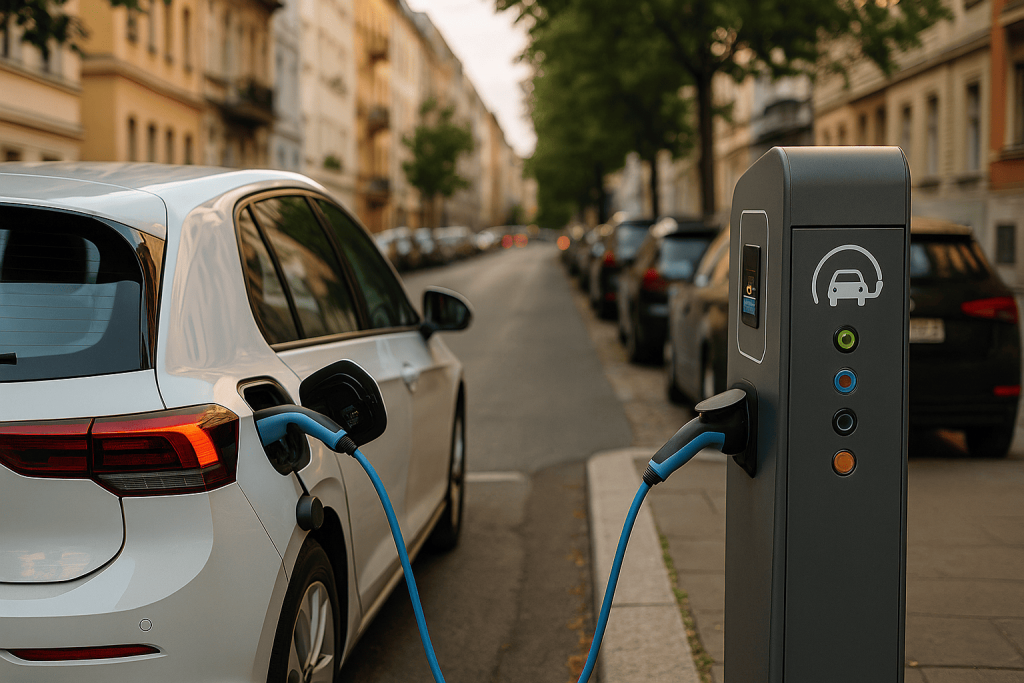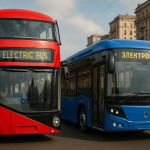The Urban EV Myth—Busted
One of the most persistent misconceptions about electric-vehicle ownership is that you need a private driveway and a powerful wallbox to make daily life workable. In reality, most Europeans—especially those in historic city centers—park on the street or in shared courtyards. Yet EV registrations in places like Amsterdam, Oslo, Paris and Berlin are soaring. How? By treating the city itself as the “garage” and leaning on a fast-evolving ecosystem of public, semi-public and shared charging options.
Curbside Power: Europe’s Dense Public-Charging Web
Across the EU-27 there are now more than 600 000 publicly accessible charge points, with roughly half installed in urban areas. Lamp-post chargers in London’s Kensington, pay-to-plug sockets on Copenhagen’s residential curbs, and fast hubs next to Parisian roundabouts ensure that a charging cable is never far away. Cities that once struggled with on-street clutter now integrate slim AC posts into existing street furniture, while rapid 150–350 kW DC chargers appear at petrol-station forecourts, grocery-store car parks and transit interchanges.
Top-Up Mentality: Charging Like You Charge Your Phone
Garage-free drivers don’t “fill the tank” once a week; they add small bursts of energy whenever the car is parked anyway. Twenty minutes at a 75 kW charger during a supermarket run adds 150 km of range—more than most Europeans drive in three days. Evening dinners, gym sessions or cinema visits become opportunities to plug in. The habit shift is subtle: think how much time can I spare right now? rather than how empty is my battery?
Digital Tools: Your New EV Co-Pilot
Apps such as Chargemap, PlugShare, Electromaps and A Better Routeplanner (ABRP) provide real-time data on socket types, power levels, pricing and occupancy. RFID cards or smartphone wallets unlock dozens of roaming networks through a single subscription—Shell Recharge, Ionity Passport or Maingau Power, for instance. Many municipal chargers even activate via QR code and bill you by the minute, the kilowatt-hour or a flat overnight tariff.
The Economics: Still Cheaper than Petrol
Public charging is typically 20–40 % pricier than home AC electricity, yet the total monthly outlay still beats petrol costs by a comfortable margin. Consider a compact EV that averages 17 kWh/100 km: at €0.45 /kWh (typical urban AC rate) you pay about €7.65 for 100 km. In contrast, a petrol hatchback consuming 6 L/100 km at €1.80 /L costs €10.80 for the same distance. Add lower maintenance (no oil, belts or exhaust systems) and congestion-zone discounts, and the maths stays firmly in the EV’s favour.
Policy Muscle: Cities That Back Their Citizens
Municipalities realise that equitable electrification hinges on people without private parking. Incentive menus now include:
• On-street charger requests—residents in Barcelona, Vienna or Hamburg can petition for a new socket near their building, often installed within 6–12 months.
• Resident overnight rates—off-peak flat fees as low as €0.25 /kWh in Prague or Milan make nocturnal top-ups affordable.
• EV-only street bays—priority parking near homes and workplaces, sometimes free for the first two hours.
• Zero-emission zones—driving into central Madrid or Paris is heavily discounted (or free) for pure EVs, nudging ownership toward battery power.
Case Study: Amsterdam’s “Open Charge” Network
The Dutch capital operates more than 4 300 public chargers—roughly one for every seven EVs in the city. Residents submit a charger request online once they buy or order an EV. The municipality maps demand clusters, installs a 22 kW post on-street, and guarantees green electricity. Average walking distance to a plug is now under 250 m, proving that public infrastructure can effectively replace a private garage.
Fast Hubs for Weekend Warriors
Longer journeys still require high-power DC stations. European motorway corridors—TEN-T, Ionity, Fastned, Mer—place 350 kW chargers every 60 km on major routes, letting urban drivers blast from 10 % to 80 % in 18–25 minutes. Many new hubs feature drive-through lanes, roof canopies with solar panels, restrooms and coffee bars—turning “refuelling” into a brief comfort break rather than a chore.
Shared & Flexible Ownership: When You Don’t Need a Car 24/7
All-electric car-sharing fleets (Share Now, Zity, GreenMobility, WeShare) blanket dozens of European cities. Vehicles are dropped curbside and re-charged by the operator, meaning a user never touches a cable. Subscription models like Lynk & Co let members swap or pause usage monthly. For urbanites who drive sporadically, access can trump ownership.
Design Innovations: Plug-and-Play Lamp Posts & Wireless Pads
Start-ups in the UK and Germany retrofit LED streetlights with 5-kW sockets, leveraging existing power feeds and avoiding fresh trenching. Pilot projects in Norway and France test 11 kW wireless pads flush with the asphalt—just park and induction takes over. Though early-stage, these ideas point toward a future where charging hardware disappears into urban fabric.
Overcoming Anxiety: Battery Buffers & Winter Tips
Modern EVs arrive with 400–550 km WLTP range. Even in winter, 70 % of that capacity covers a week of intra-city driving. Smart pre-conditioning warms the battery while the car is still plugged in, preserving range. Heated seats and wheels sip less energy than blasting the cabin fan, and Eco drive modes smooth throttle spikes. Collectively, these tweaks make cold-weather life manageable without nightly home charging.
Looking Ahead: Cities as Giant Charging Ecosystems
By 2030, the EU expects at least 3 million public charge points—five times today’s figure. Grid operators plan low-voltage upgrades and battery-buffered cabinets to dodge costly sub-station expansions. Vehicle-to-grid (V2G) pilots already let parked delivery vans in Utrecht return power during evening peaks, rewarding owners with energy credits. As these pilots mature, every curbside EV could become a mini power plant stabilising the local grid.
Conclusion
A private driveway is convenient, but it is no longer a prerequisite for electric mobility. With dense curbside infrastructure, smart tariffs, roaming apps and forward-thinking policies, European cities are proving that the street itself can be your charger—and the neighbourhood your energy hub. For millions of apartment dwellers, “no garage” no longer means “no EV.” The asphalt outside your front door is ready; all that’s left is to plug into the future.



street charging still sus 👎